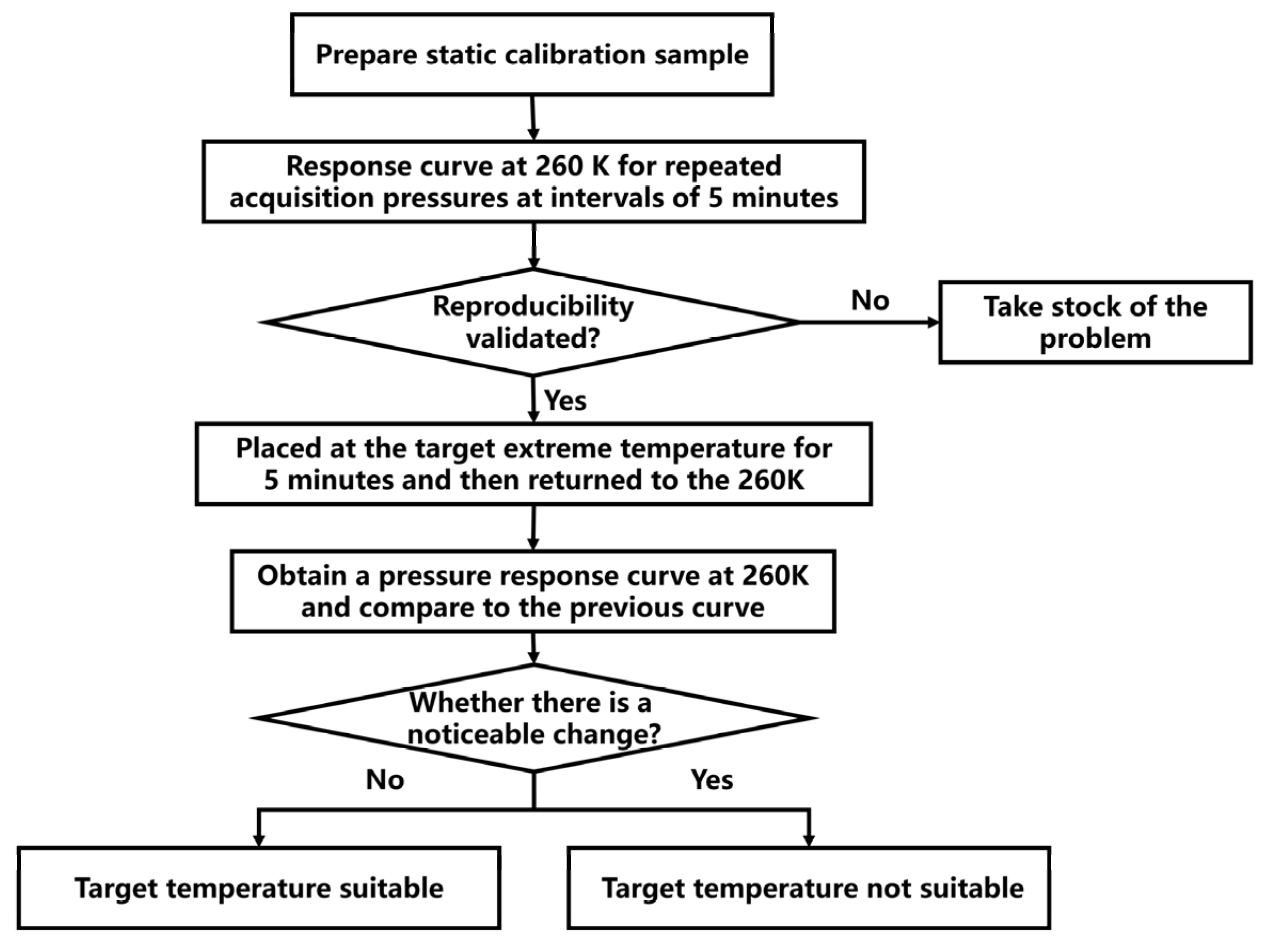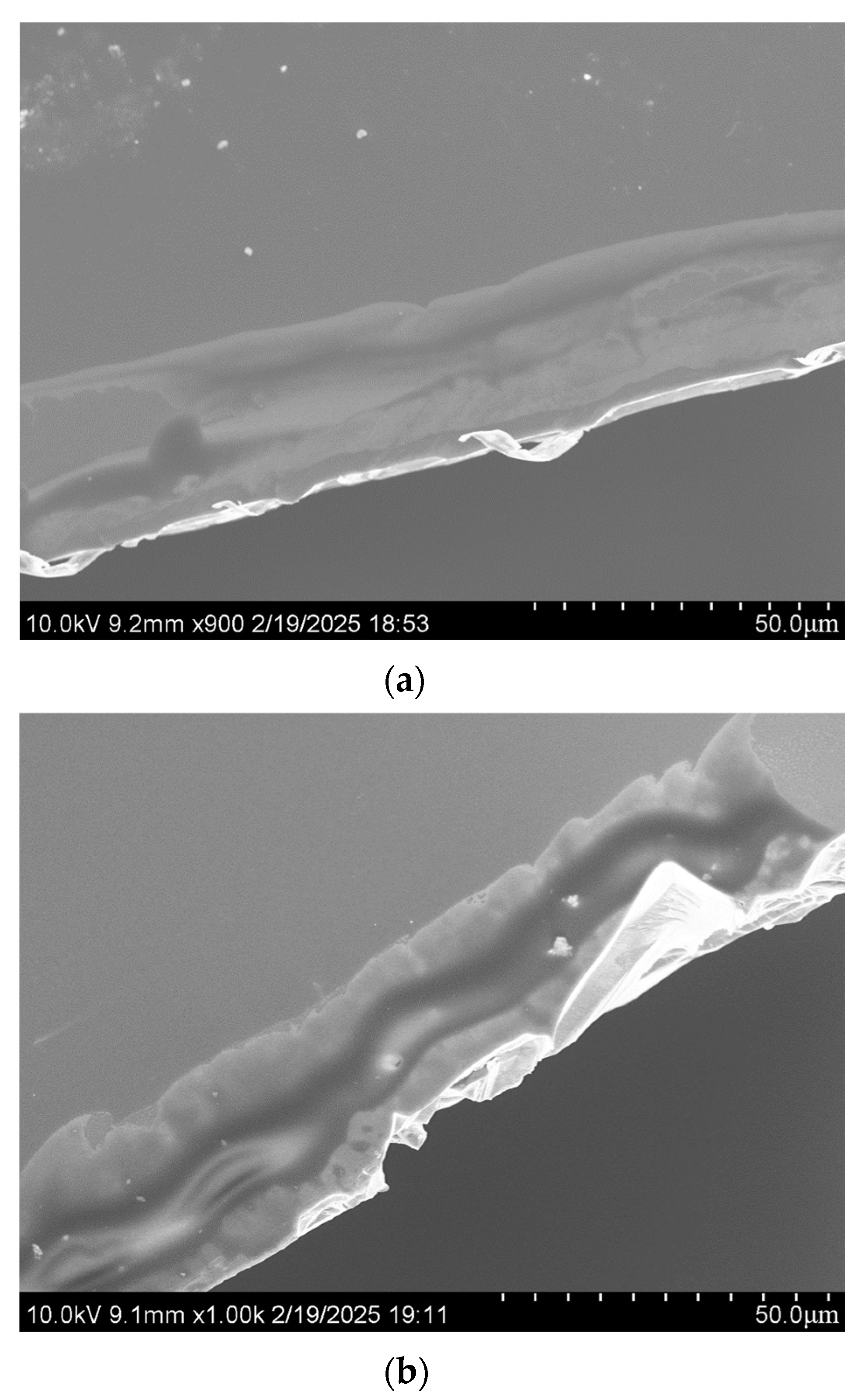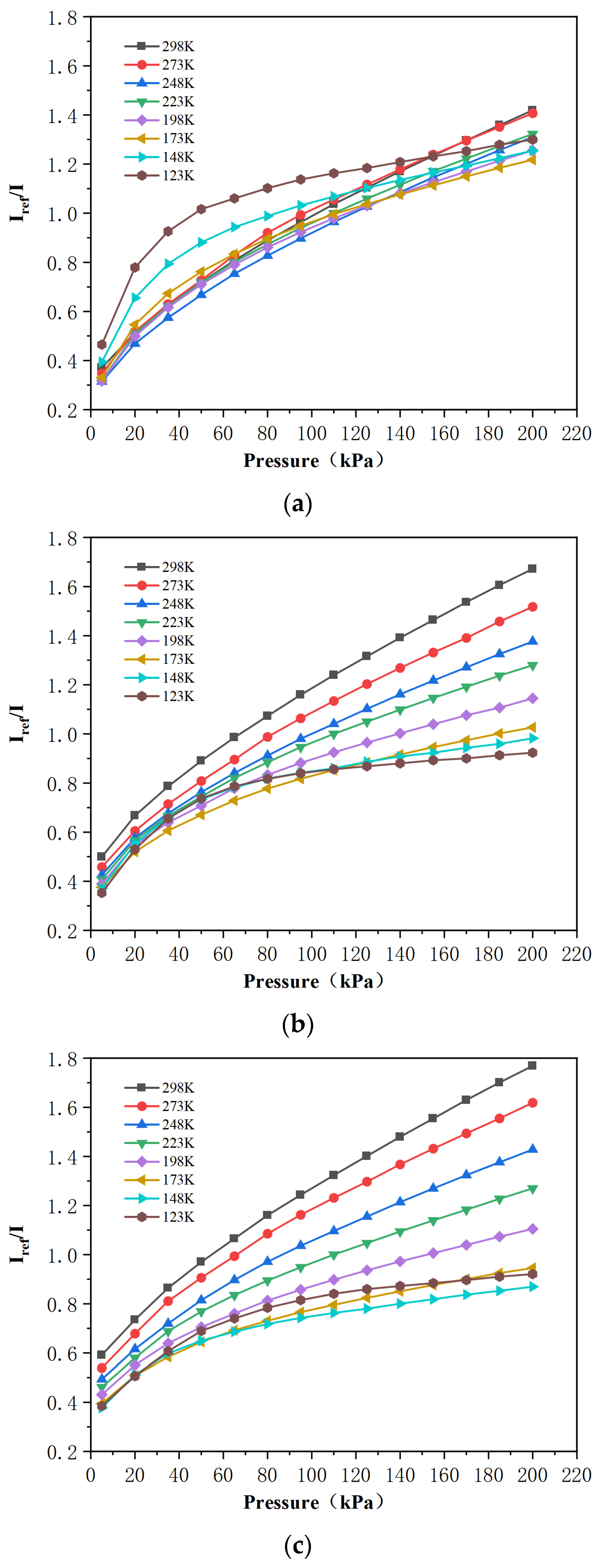Experimental Investigation on Temperature Effects of Cryogenic Pressure-Sensitive Paint
Abstract
1. Introduction
2. Experimental Methods and Calibration System
2.1. Cryogenic PSP Coating Spraying
2.2. The Calibration System
3. Results and Discussion
3.1. Effect of High Temperature on Paint Properties
3.2. Effect of Temperature on Luminous Intensity
3.3. Effect of Temperature on Pressure Sensitivity
4. Conclusions
- When the temperature reaches 323 K, coatings can accelerate aging, leading to significant and irreversible changes in coating performance.
- The thermal quenching effect of PSP has significant changes over time. In the initial stage, both fluorescence emission thermal quenching and anti-thermal quenching phenomena coexist, and after 72 h, the overall appearance is a single thermal quenching phenomenon. As time passes, the PSP structure tends to stabilize and eventually exhibits a similar thermal quenching trend as conventional PSP. In addition, the temperature quenching effect increases from 72 to 144 h.
- As the temperature decreases, the overall pressure sensitivity of PSP decreases. After 144 h at a temperature of 123 K, the pressure sensitivity of the PSP was 0.244%/kPa, and the overall pressure sensitivity changed by 15.8% compared to 24 h after spraying.
Author Contributions
Funding
Data Availability Statement
Conflicts of Interest
Abbreviations
| PSP | pressure-sensitive paint |
| PTMSP | Polymer polytetramethylsiloxane |
| PtTFPP | Platinum tetra (pentafluorophenyl) porphyrin |
| FFV | the free volume fraction |
| RMS | the root mean square |
| SEM | scanning electron microscope |
References
- Asai, K.; Amao, Y.; Iijima, Y.; Okura, I.; Nishide, H. Novel Pressure-Sensitive Paint for Cryogenic and Unsteady Wind-Tunnel Testing. J. Thermophys. Heat Transf. 2002, 16, 109–115. [Google Scholar] [CrossRef]
- Klein, C.; Yorita, D.; Henne, U. Comparison of Lifetime-Based Pressure-Sensitive Paint Measurements in a Wind Tunnel Using Model Pitch–Traverse and Pitch–Pause Modes. Photonics 2024, 11, 546. [Google Scholar] [CrossRef]
- Liu, T.; Sullivan, J.P.; Asia, K.; Klein, C.; Egami, Y. Pressure and Temperature Sensitive Paints, 2nd ed.; Springer: Cham, Switzerland, 2021; ISBN 978-3-030-68055-8. [Google Scholar] [CrossRef]
- Yorita, D. Application of Lifetime-based Pressure-Sensitive Paint Technique to Cryogenic Wind Tunnel Test. In Proceedings of the 54th AIAA Aerospace Sciences Meeting, San Diego, CA, USA, 4–8 January 2016. [Google Scholar] [CrossRef]
- Li, G.S.; Zhou, Q.; Liu, X.; Jin, B.Q.; Gao, L.M.; Ma, H.S.; Xiong, J. Experimental Research of Pressure Sensitive Paint Performance and Calibration Technique. Acta Aeronaut. Astronaut. Sin. 2013, 34, 227–234. [Google Scholar] [CrossRef]
- Kurihara, D.; Egami, Y.; Sakaue, H. Luminescent intensity enhancement of pressure-sensitive paint by optimization of mole fraction of oxygen. Aerosp. Sci. Technol. 2021, 112, 106627. [Google Scholar] [CrossRef]
- Matsuyama, T.; Nagata, T.; Kasai, M.; Nonomura, T. Improvement of Pressure-sensitive-paint Measurement of Rotating blades by Adjusting Oxygen Concentration under Low-pressure Conditions. In Proceedings of the AIAA SCITECH Forum, National Harbor, MD, USA, 23–27 January 2023. [Google Scholar] [CrossRef]
- Watkins, A.N.; Goad, W.; Bell, J.; Ingram, J.; Campbell, R.; Obara, C.; Sprinkle, D.; Carter, M.; Oglesby, D.; Underwood, P.J.; et al. Flow Visualization at Cryogenic Conditions Using a Modified Pressure Sensitive Paint Approach. In Proceedings of the 43rd AIAA Aerospace Sciences Meeting and Exhibit, Reno, NV, USA, 10–13 January 2012. [Google Scholar] [CrossRef][Green Version]
- Furuya, T.; Nakai, T.; Imai, M.; Kameda, M. Characterization and Improvement of Heat Resistance of a Polymer-Ceramic Pressure-Sensitive Paint at High Temperatures. Sensors 2021, 21, 8177. [Google Scholar] [CrossRef] [PubMed]
- Watkins, A.; Leighty, B.; Lipford, W.; Oglesby, D.; Goodman, K.; Goad, W.; Goad, L.; Massey, E. The Development and Implementation of a Cryogenic Pressure Sensitive Paint System in the National Transonic Facility. In Proceedings of the 47th AIAA Aerospace Sciences Meeting Including the New Horizons Forum and Aerospace Exposition, Orlando, FL, USA, 5–8 January 2012. [Google Scholar] [CrossRef]
- Yorita, D.; Klein, C.; Henne, U.; Ondruš, V.; Beifuss, U.; Hensch, A.-K.; Longo, R.; Guntermann, P.; Quest, J. Successful Application of Cryogenic Pressure Sensitive Paint Technique at ETW. In Proceedings of the 2018 AIAA Aerospace Sciences Meeting, Kissimmee, FL, USA, 8–12 January 2018. [Google Scholar] [CrossRef]
- Hayashi, T.; Sakaue, H. Temperature Effects on Polymer-Ceramic Pressure-Sensitive Paint as a Luminescent Pressure Sensor. Aerospace 2020, 7, 80. [Google Scholar] [CrossRef]
- Chen, W.-C.; Huang, C.-Y.; Tan, K.-T.; Sakaue, H. The Development and Application of Two-Color Pressure-Sensitive Paint in Jet Impingement Experiments. Aerospace 2023, 10, 805. [Google Scholar] [CrossRef]
- Klein, C. Time resolved pressure measurements by means of PSP in cryogenic conditions. In Proceedings of the AIAA SCITECH 2022 Forum, San Diego, CA, USA, 3–7 January 2022. [Google Scholar] [CrossRef]
- Okudera, T.; Nagata, T.; Kasai, M.; Saito, Y.; Nonomura, T.; Asai, K. Effect of Oxygen Mole Fraction on Static Properties of Pressure-Sensitive Paint. Sensors 2021, 21, 1062. [Google Scholar] [CrossRef] [PubMed]
- Egami, Y.; Fey, U.; Engler, R. Appropriate Selection of Pressure-Sensitive Paint for Cryogenic Wind Tunnels. In Proceedings of the 44th AIAA Aerospace Sciences Meeting and Exhibit, Reno, NV, USA, 9–12 January 2012. [Google Scholar] [CrossRef]
- Kurihara, D.; Sakaue, H. Temperature Dependency Model in Pressure Measurement for the Motion-Capturing Pressure-Sensitive Paint Method. Sensors 2023, 23, 9714. [Google Scholar] [CrossRef] [PubMed]
- Egami, Y.; Fujii, K.; Takagi, T.; Matsuda, Y.; Yamaguchi, H.; Niimi, T. Reduction of Temperature Effects in Pressure-Sensitive Paint Measurements. AIAA J. 2013, 51, 1779–1783. [Google Scholar] [CrossRef]
- Woodmansee, M.A.; Dutton, J.C. Methods for treating temperature-sensitive effects of pressure-sensitive paints. In Proceedings of the 35th Aerospace Sciences Meeting and Exhibit, Reno, NV, USA, 6–9 January 1997. [Google Scholar] [CrossRef]
- Peng, D.; Jensen, C.D.; Juliano, T.J.; Gregory, J.W.; Crafton, J.; Palluconi, S.; Liu, T. Temperature-Compensated Fast Pressure-Sensitive Paint. AIAA J. 2013, 51, 2420–2431. [Google Scholar] [CrossRef]
- Liu, T.; Bencic, T.; Sullivan, J.P. Pressure Sensitive Paints; Langley Research Center: Hampton, VA, USA, 1999.
- Bencic, T.J. Pressure-Sensitive Paint Measurements on Surfaces with Non-Uniform Temperature. In Proceedings of the Instrumentation Conference, Albuquerque, NM, USA, 2–6 May 1999. Document ID: 19990116722. [Google Scholar]
- Bakhtin, D.; Bazhenov, S.; Polevaya, V.; Grushevenko, E.; Makaev, S.; Karpacheva, G.; Volkov, V.; Volkov, A. Aging of Thin-Film Composite Membranes Based on Crosslinked PTMSP/PEI Loaded with Highly Porous Carbon Nanoparticles of Infrared Pyrolyzed Polyacrylonitrile. Membranes 2020, 10, 419. [Google Scholar] [CrossRef] [PubMed]









| Calibration Sample | 260 K Before Heating | 260 K Repeatability Before Heating | 260 K After Heating |
|---|---|---|---|
| Sample 1 | 0.497%/kPa | 0.498%/kPa | 0.499%/kPa (303 K Heating) |
| Sample 2 | 0.503%/kPa | 0.504%/kPa | 0.497%/kPa (313 K Heating) |
| Sample 3 | 0.498%/kPa | 0.498%/kPa | 0.452%/kPa (323 K Heating) |
Disclaimer/Publisher’s Note: The statements, opinions and data contained in all publications are solely those of the individual author(s) and contributor(s) and not of MDPI and/or the editor(s). MDPI and/or the editor(s) disclaim responsibility for any injury to people or property resulting from any ideas, methods, instructions or products referred to in the content. |
© 2025 by the authors. Licensee MDPI, Basel, Switzerland. This article is an open access article distributed under the terms and conditions of the Creative Commons Attribution (CC BY) license (https://creativecommons.org/licenses/by/4.0/).
Share and Cite
Qiao, P.; Wu, J.; Huang, H.; Li, G.; Li, D.; Du, H. Experimental Investigation on Temperature Effects of Cryogenic Pressure-Sensitive Paint. Aerospace 2025, 12, 329. https://doi.org/10.3390/aerospace12040329
Qiao P, Wu J, Huang H, Li G, Li D, Du H. Experimental Investigation on Temperature Effects of Cryogenic Pressure-Sensitive Paint. Aerospace. 2025; 12(4):329. https://doi.org/10.3390/aerospace12040329
Chicago/Turabian StyleQiao, Peng, Jifei Wu, Hui Huang, Guoshuai Li, Da Li, and Hai Du. 2025. "Experimental Investigation on Temperature Effects of Cryogenic Pressure-Sensitive Paint" Aerospace 12, no. 4: 329. https://doi.org/10.3390/aerospace12040329
APA StyleQiao, P., Wu, J., Huang, H., Li, G., Li, D., & Du, H. (2025). Experimental Investigation on Temperature Effects of Cryogenic Pressure-Sensitive Paint. Aerospace, 12(4), 329. https://doi.org/10.3390/aerospace12040329





